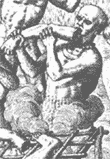
 |
Ethno::log |
|
Genetic Researchers: Cannibalism was widely spread  Human flesh may have been a fairly regular menu item for our prehistoric ancestors, according to researchers. They say it's the most likely explanation for their discovery that genes protecting against prion diseases -- which can be spread by eating contaminated flesh -- have long been widespread throughout the world, reports Science Daily.
Human flesh may have been a fairly regular menu item for our prehistoric ancestors, according to researchers. They say it's the most likely explanation for their discovery that genes protecting against prion diseases -- which can be spread by eating contaminated flesh -- have long been widespread throughout the world, reports Science Daily.
The study was originally presented in the Science Magazine (only for subscribers - students from Munich University can access it from our library pc's) As cannibalism is always worth a headline (the engraving above, used in early newspapers is 500 years old), also NYTimes (free subscription necessary) and Süddeutsche Zeitung (11.4.03, Panorama) are reporting. National Geographic even titles "Cannibalism Normal For Early Humans?". Which is a bit overdrawn, I think, as the whole assumption already seems to be mainly speculation. ... Link (0 comments) ... Comment Dept. of , h-man8, April 11, 2003 at 12:48:33 AM CEST XML, stylesheets and Maya culture Where's the connection between the ancient culture of the Mayas, the web-language XML and stylesheets? For an answer let's first time-warp back to 1989. Tim Berners Lee 'invented' the WWW and shortly afterwards the markup-language HTML surfaced -- created for the inter-human communication. For this means HTML was an ingeniously simple language by which thoughts easily could be transformed into pictures and given a shape. But soon HTML showed to be insufficient for being handled by machines. Machines don't understand the semantics of pictures, and HTML unifies shape and semantics of a website into one document. Therefore XML was developed which follows the paradigm of structurized documents. Content, structure and shape are separated. XML has the content and an XLS-stylesheet covers the shape of a modern web-document. But alas, this thought of splitting-up a piece of information into content and shape isn't new at all. The Mayas already were knowladgeable of this strategy/technology. On March 21st and September 23rd the shadows cast by the sun reveal a winding serpent at the pyramid of Kukulacan at Chichen Itza -- proof of the aforementioned strategy. The information to be carried, the serpent, represents the XML-document. The sun and the pyramid's architecture constitute a kind of stylesheet, which gives structure and shape to the serpent. Now -- are the Mayas the founding-fathers of the paradigm of structurized documents? ... Link (6 comments) ... Comment |
The finest stuff from ethnology social/cultural anthropology and cyberanthropology. Collected with ceaseless endeavour by students and staff of the Institut für Ethnologie in München/Germany and countless others.
... about this website Online for 8955 days Last modified: 11/29/22, 8:56 PM Search
Browse by Category
Status
Youre not logged in ... Login
Menu
Calendar
Recent updates
Schade Oh, so bad! The
oldest anthropology blog is closing :(( It seems the whole...
by iglu01 (1/4/20, 4:05 PM)
-- Closed -- I think
it's time to close the weblog, it's already sleeping since...
by kerleone (12/29/19, 1:54 PM)
Stellenausschreibung des Max-Planck-Instituts für ethnologische
Forschung. Bewerbungsfrist: 15.02.2017 Das Max-Planck-Institut für ethnologische Forschung sucht Doktoranden/Doktorandinnen...
by HatEl (1/31/17, 9:11 AM)
Ethnosymposium in Halle (Saale): Call
for Contribution – 14.-17. Mai 2015 Call for Contribution –...
by normanschraepel (2/9/15, 3:35 PM)
Bruno Latour: Kosmokoloss. Eine Tragikomödie
über das Klima Der Hörspiel Pool von Bayern 2 hat...
by pietzler (11/21/14, 3:23 PM)
Send us suggestions
|